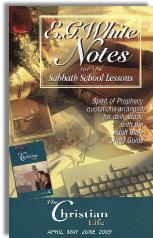|
||||||||||
Commentary on "Grace"
Day 1: Sabbath Afternoon, May 9, 2009
Overview
The introduction to this lesson starts with an excerpt from Philip Yancey’s book, What’s So Amazing About Grace? which states that the Christian belief is unique in that it is the only one that believes in grace. Without defining what grace actually is, the author of the lesson simply states that it was “a divine intervention”, and that throughout the lesson we would be addressing the following questions:
- What are some of the images God uses to teach us the plan of salvation?
- What is atonement?
- How central is the concept of substitution to our understanding of the Cross
Behind the words
While one cannot argue that sin was conquered through “divine intervention”, this vague thought leaves one wondering exactly what is meant by that. The E.G White Notes that correspond with this lesson bring clarity to the false theology behind this phrase and how it plays into the definition of grace. “It was the love of the Father for fallen man that devised in union with the Son the plan of redemption. And in this great gift the character of God is exemplified to all who shall receive the world’s Redeemer by faith, as a God of holiness and a God of love. In the crucifixion of his dear Son upon the cross of Calvary, he gives to all the sons and daughters of Adam an expression of his justice and his love. This offering made manifest the immutability of the holiness of his law.” Sign of the Times, December 23, 1897.
The above quote is filled with problems that reveal an underlying misunderstanding of the Trinity, the heretical view of “The Great Controversy”, and a false premise of what the holiness of the law is.
Problems
1. Understanding of the Trinity
“It was the love of the Father for fallen man that devised in union with the Son the plan of redemption.”
This quote clearly implies that the Father and Son are separate from each other. This is not biblical. The Father did not need to “devise in union with the Son” because they are both ONE God. God is triune: three coexistent, co-eternal persons that make up God. This does NOT mean three Gods. John 10:38 says, “...so you may know and understand that the Father is in Me, and I in the Father”. John 14:7-11 further describes this “oneness” with the Father.
2. The Great Controversy
“And in this great gift the character of God is exemplified to all who shall receive the world’s Redeemer by faith, as a God of holiness and a God of love. In the crucifixion of his dear Son upon the cross of Calvary, he gives to all the sons and daughters of Adam an expression of his justice and his love.”
The act of redemption had nothing to do with the character of God being exemplified. The Bible is clear that God is sovereign over everything, including Satan. He does not need to prove that He is a “God of holiness and a God of love”. He IS those things, apart from what creation thinks. The Bible never suggests that God’s character has been in question. Job recognized God’s sovereignty in Job 42:1-6. Also, Romans 9:20, 21 clearly describes the nature of God’s sovereignty as well as our “right” to question God.
3. Holiness of the Law
“This offering made manifest the immutability of the holiness of his law.”
While this passage does not address exactly what “his law” is, it is implied throughout the rest of the lessons, as well as in the fundamental beliefs of the Adventist church, that this is referring to the Ten Commandments. To put this in proper Biblical perspective, it needs to be clarified that God Himself is what is immutable, not the Ten Commandments. God Himself is what is holy, not the Ten Commandments. The Ten Commandments are not timeless. In fact, according to the Bible, the Ten Commandments clearly had a beginning and an end. Galatians 3:15 states the beginning of the Law came four hundred and thirty years after Abraham, and ended when the seed came (verse 19). Romans 8:2-4 completely contradicts the above quote in describing what “this offering” really did:
“For the law of the Spirit of life in Christ Jesus has set you free from the law of sin and of death. For what the Law could not do, weak as it was through the flesh, God did: sending His own Son in the likeness of sinful flesh and as an offering for sin, He condemned sin in the flesh.”
Summary
- “Divine intervention” is a deceptive phrase that sounds “correct”, but undermines the Trinity and the sovereignty of God.
- There is ONE God, made up of three co-existent, co-eternal persons.
- God is holy, just, and loving apart from the cross, and apart from how creation saw the act of redemption.
- God Himself is immutable and holy, not the Ten Commandments.
Copyright 2009 BibleStudiesForAdventists.com. All rights reserved. Revised May 7, 2009. This website is published by Life Assurance Ministries, Glendale, Arizona, USA, the publisher of Proclamation! Magazine. Contact email: BibleStudiesForAdventists@gmail.com.
The Sabbath School Bible Study Guide and the corresponding E.G. White Notes are published by Pacific Press Publishing Association, which is owned and operated by the Seventh-day Adventist church. The current quarter's editions are pictured above.
Official Adventist Resources
Standard Edition Study Guide Week 7
Teacher's Edition Study Guide Week 7
Easy Reading Edition Study Guide Week 7
Search the Complete Published Ellen G. White Writings


